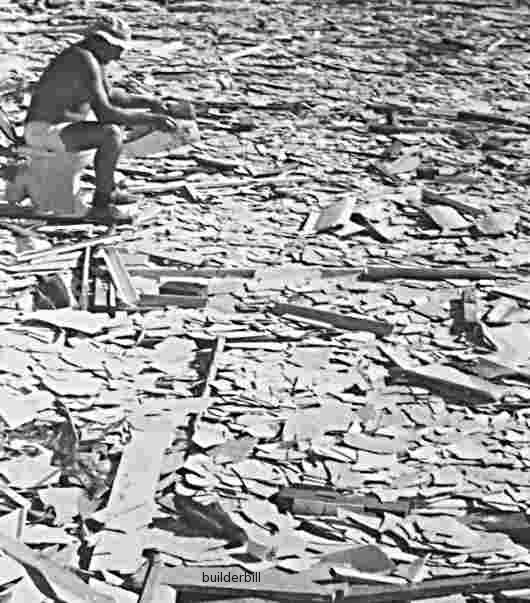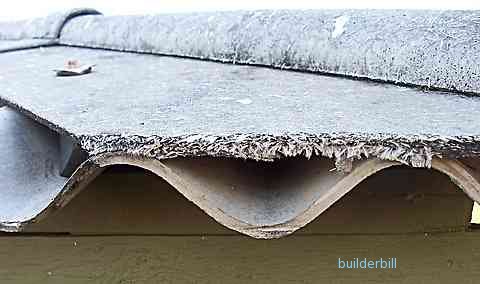 |
||||||||
Asbestos danger in the home, what are the risks?You may ask "what's all this talk about asbestos danger"?
Anyone who reads the news or watches the TV will know of the law suits, massive payouts, and the untold misery and suffering of thousands of workers and their families who were exposed to asbestos in their workplaces for many years. What are the asbestos dangers?There are tonnes of information out on the web quoting various statistics, charges and counter charges from opposite camps, but what everyone seems to agree on are a few basic facts.
As I said in my introduction page, I used to have a couple of mates who both died of asbestos related cancer. Vince and Martin were cousins, both internal trim carpenters and for many years they worked as a team doing sub-contact work. A few years ago Martin died of asbestos related throat cancer, and within a year Vince was diagnosed with the same disease and died also.. Both of them say that it was caused by a job that they did in the early 1990's removing AC sheeting without correct protection. What are the risks of living in a home that contains asbestos cement type products. AC sheeting, AC siding etc.Quite simply my view is that I would not be unduly worried for myself and my family living in a home that was clad externally or internally with any of those products. Sooner or later though I would take steps to renovate at least the inside of the house, by removing or covering up the offending sheet materials. Asbestos cement is an incredibly stable material if it is undisturbed and not subjected to extreme weathering. To protect against weathering which eventually would release fibres into the atmosphere I would keep the external surfaces painted and well maintained. My View, Take the Risk or Not.
The photo above was taken with a bit of humour at the time, but now I cringe when I see It. How could we all have been so ignorant? Both Col and myself are still fit and well (2009), touch wood. In my early days in Australia I handled an awful lot of FAC. For the most part it was flat sheets and was cut with Fibro cutters, which made little dust. Even so, sweeping up the scraps etc. exposed us to the dust. We were definitely exposed to asbestos danger for days at a time on sites like this.
In the above photo, of a hip flashing on a "Super Six" corrugated FAC roof you can get an idea of how many asbestos fibres are actually in there. You can also plainly see that the corrugated sheet underneath was cut with a grinder or more probably a power saw with an abrasive disk. When we fixed the corrugated sheeting, there was only one tool, an abrasive disk in a grinder or saw to cut the stuff, and it had to be cut a lot. we did not the same diamond / wet cutting tools that are available today. At at the hips all the the sheets had to be cut with a disk. Sheets did not come in long lengths like today's modern metal roofing, so each overlapping sheet in the length also had to have a corner cut off, also by disk, so thousands of building workers, not to mention people near building sites were exposed to the asbestos danger of the blowing dust. In the 60's and 70's there were vague warnings about using masks etc. and for the most part we used them, but again they were not as good and as cheap as modern masks. The manufacturers of these products knew well the toxicity of their products, even as early as the 50's and 60's but for their own reasons they chose to ignore or to play down the asbestos dangers contained in So, myself and thousands like me got were exposed to asbestos dust. I am still OK and so are thousands of others. Would I do it in the same way again? NO WAY. I believe it's a bit like a lottery, millions of us have not yet got that ticket to hospital. It seems that the longer and the greater the exposure to asbestos danger, the greater the risk of contracting a disease, yet as I mentioned before, there does not seem to be a safe limit to any kind of exposure to asbestos fibres. IF YOU HAVE TO REMOVE ASBESTOS, CALL IN A PROFESSIONAL. IF IT IS ONLY A SMALL AMOUNT AND THE REGULATIONS IN YOUR AREA ALLOW YOU TO DO IT YOURSELF, DO IT CORRECTLY, FOLLOW THE GUIDELINES. Not found it yet? Try this FAST SITE SEARCH or the whole web |
Hire Equipment  Furniture Fittings - Architectural Hardware - Electronic Locking Systems - Technical Hardware BuilderBill sponsorship Asbestos related pages.NEW -Asbestos Glossary Introduction to asbestos in house constructionAsbestos Containing Products How to identify asbestos. Asbestos Danger Asbestos Management Asbestos Removal Reader's QuestionsAsbestos houseAsbestos house renovation. Asbestos Tilux. Asbestos-cladding Asbestos - Disclaimer.This is a highly complex and stringently regulated field. I am not a scientist, I am not a government spokesperson or anyone with any authority to talk or give professional advice on the subject in your area. What I am is a retired builder with a large amount of practical experience fixing fibrous asbestos cement products and then later removing them. In 1995 I was issued an asbestos removal licence (43133) by the Northern Territory Work Health Authority, and did many asbestos removal jobs, complying with Australian Work Health (OH&S) Regulations and the NOHSC National Code Of Practice For The Safe Removal Of Asbestos. I hope you get something of value out of these pages, but a word of caution, at the last count I get visitors from 132 different countries, there is no way that I can give specific advice that would comply with the regulations in your country, state, district or local area. In other words, the onus is on YOU to check out the regulations where you live, and comply with them. If you have any doubts get advice from a licensed person IN YOUR AREA. |
|||||||
|
|
||||||||
|
Please Note! The information on this site is offered as a guide only! When we are talking about areas where building regulations or safety regulations could exist,the information here could be wrong for your area. It could be out of date! Regulations breed faster than rabbits! You must check your own local conditions. Copyright © Bill Bradley 2007-2012. All rights reserved. |
||||||||

